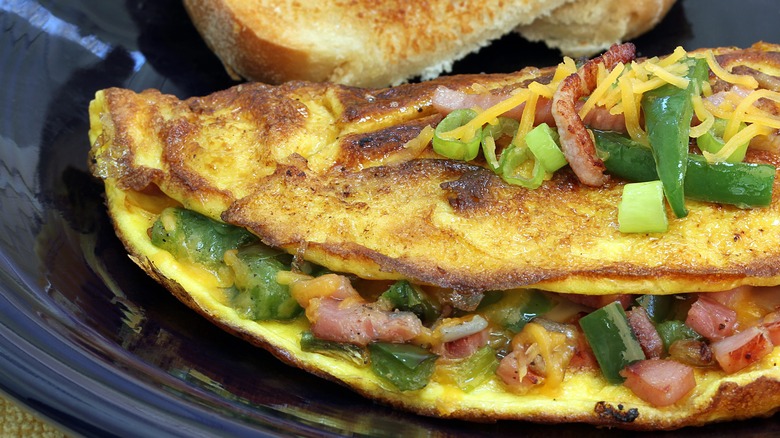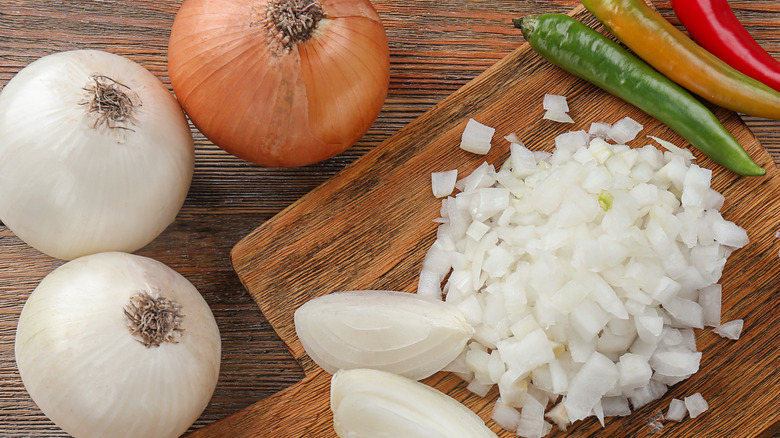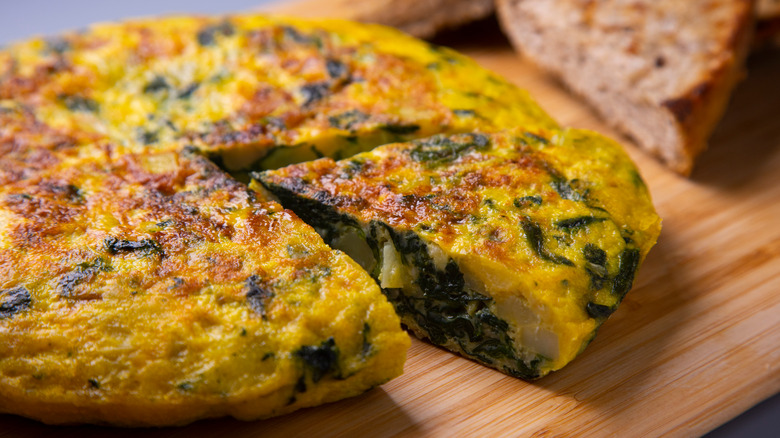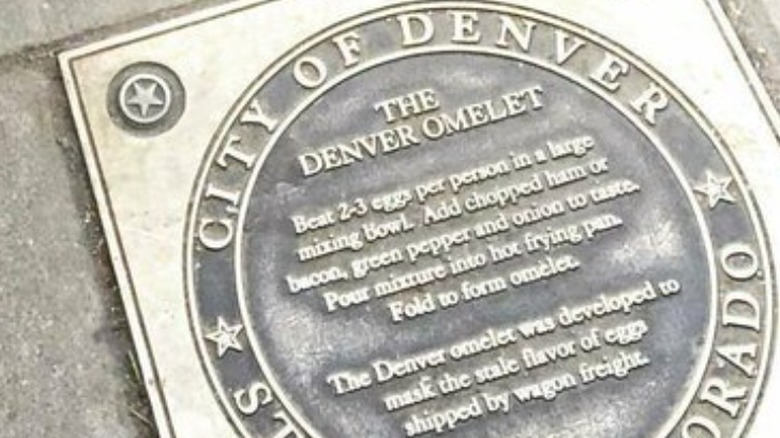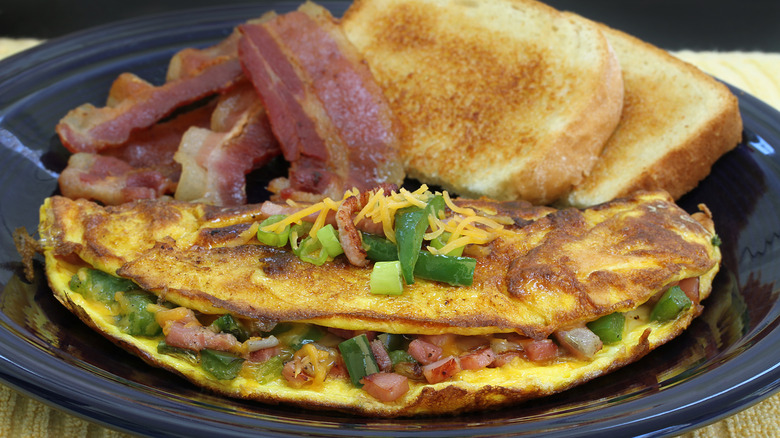What Is A Denver Omelet, And What Does It Taste Like?
If you've visited a diner for breakfast over the years, you've likely stumbled upon the Denver omelet (sometimes called a Western omelet). The history of this dish is a bit mysterious and filled with cowboys, gold prospectors, and Chinese immigrants building railroads across the American Old West. The Denver omelet resembles both the Spanish omelet and egg foo young, which could be a hint to its evolution over time and fusion food history. There's also a chance it could have started life as a sandwich.
Oddly enough, finding a Denver omelet or a Denver sandwich around the city of Denver, Colorado, itself these days proves to be a tricky endeavor. Trendy breakfast spots in Denver have started to overlook this time-honored omelet in favor of other more modern breakfast menu items. Still, the Denver omelet endures as one of the few named omelets you'll still find from coast to coast in U.S. restaurants. We'll take a look at all the ingredients that go into a Denver omelet, its murky origins, and a few other interesting facts about this iconic breakfast food.
Denver omelets are full of yummy ingredients
While the combination of ingredients you can put in an omelet is endless, the Denver omelet has specific components. In fact, the recipe is immortalized on a plaque in downtown Denver, which lists eggs mixed with several chopped ingredients: ham or bacon, green peppers, and onions. When ordering a Denver omelet from a restaurant, most menus feature ham, but you may also find bacon in addition to or instead of the ham. However, the plaque is missing one key ingredient that nearly every American omelet has today: cheese. A Denver resident told Perspectives on History, "If it doesn't have cheese, I'm not even talking to you."
If you see a Western omelet on a breakfast menu, it's often the same thing as a Denver omelet. However, some restaurants, like Sam's No. 3 in Denver, only call it a Western omelet if it also comes with chopped tomatoes. So, if the ingredients matter to you and the menu doesn't list the ingredients, you might want to ask. However, in general, you're going to get peppers, onions, ham, and/or bacon.
The taste depends on your choice of ingredients
While you would think that every Denver omelet would taste the same, it's going to depend on your choice of ingredients. For example, you should know what to look for when buying ham because it can have different flavor profiles. Using smoked ham is going to lend your omelet a very different taste than salty, dry-cured ham. Cured hams may contain more chemicals, but uncured ham may be laden with extra salt and other flavors. And if you throw a bit of leftover spiced Christmas ham into your omelet, you're going to come out with something completely different.
Similarly, your bacon choice can change the flavor profile of your omelet. For example, bacon that has been hickory smoked will have a stronger smoky flavor than bacon that has been applewood smoked. However, the applewood version would taste slightly sweeter.
How about the peppers and onions? You have the option to pre-cook them or put them in raw, according to your personal preference. While most Denver omelets contain green bell peppers, there's no reason you couldn't go with another color of bell pepper or another type of pepper, depending on your pepper and heat level preference. Most people tend to use white or yellow onions for a Denver omelet. However, a red onion or even green onions can make an interesting flavor change.
One possible origin story of the Denver omelet stinks
The history of the Denver omelet is still a bit mysterious. One version that keeps popping up everywhere is the idea that the ingredients were meant to mask the flavor of rotten eggs. Who among us has ever smelled a rotten egg and thought, "I wonder what I can do to make these edible?" The sulfurous smell of rotten eggs is enough to warn most people away. Is there a ham or bacon smoky and salty enough to cover over that flavor? Onion is sulfurous itself, so is that the way to go? Or maybe an extremely hot pepper would fool your taste buds into thinking you weren't eating rotten eggs. We think not.
However, the Denver omelet origin story immortalized on a plaque in Colorado's capital city is a little more rational. It reads that the ingredients were meant to cover up the taste of old eggs, which had come a long way by wagon. The idea of covering up the wet-dog taste of old eggs with highly flavored meats, onions, and peppers is entirely more plausible.
Still, some historians have debunked this origin story. Peppers are native to South America, Central America, and the southern part of North America and stayed there until explorers exported them. Prospectors started pouring into Denver in 1858 searching for gold. However, Colorado culinary historian Adrian Miller told the Denver Post that historians don't place peppers in Denver with those early pioneers at all.
The Denver omelet might be a version of the Spanish omelet
One less-quoted origin story for the Denver omelet is that it was inspired by the Spanish omelet. The first reference to a Spanish omelet dates to a letter from 1817 in which an anonymous Spanish citizen laments that the poor are having to subsist on eggs made into a tortilla-like breakfast food with potatoes and other fillers. This dish is called a tortilla Española. Today, people sometimes add sausage, onions, cheese, or other fillers to Spanish omelets, so it has some vague similarities to the Denver omelet. Since some versions of the Denver omelet involve mixing the ingredients with raw eggs before cooking, it's plausible that the form and spirit of the Spanish omelet inspired the creation of the Denver omelet.
Colorado was a Spanish-governed territory until 1821, so there's a chance that Spaniards in the area could have brought in the concept of the Spanish omelet to combine eggs with whatever ingredients were at hand. However, Denver was founded nearly 40 years later, in 1858, after the Spaniards were no longer governing the territory. Plus, as culinary historian Adrian Miller told the Denver Post, early pioneers in the city didn't have access to peppers. So, the idea of the Spanish omelet inspiring the Denver omelet is sketchy at best.
It could have originated from Chinese egg foo young
Another origin story for the Denver omelet is that it started life as egg foo young, which originated in the U.S. with Chinese immigrants. Egg foo young is a pancake-like omelet that contains eggs, vegetables like green onions and bean sprouts, and often meat. While it's usually served with sauce, you can see how the un-sauced version resembles a Denver omelet if you decide to use peppers and onions as the vegetables and ham and/or bacon as the meat.
Egg foo young's origins in China aren't exactly clear. However, we do know that Chinese immigrants were making it during the Gold Rush while they helped to build the railroads in the Wild West. So, this places egg foo young in the era of Denver's earliest days as a gold mining town. It's very likely that the essence of egg foo young inspired cooks to later create the Denver omelet. If so, it was one of the many immigrant fusion foods in the U.S. that started as one dish and morphed into another in the hands of subsequent cooks who favored different ingredients.
Egg foo young also has a sandwich version, called the St. Paul Sandwich. When it comes to the Denver omelet, it's worth asking which came first: the omelet or the sandwich?
The Denver omelet may have started as a sandwich
It's likely that the Denver omelet didn't start life as an omelet at all. Instead, it started as the Denver sandwich — the equivalent of a Denver omelet between two slices of bread. The Denver sandwich became popular in the early 1900s and was one of the most popular U.S. sandwiches by the 1950s. During its early days, several street vendors and restaurants laid claim to it.
Rumors indicate that Denver personality Baby Doe Tabor was the original mastermind, creating the sandwich in the kitchen of her Tabor Grand Hotel. The hotel opened in 1885 but was renamed the Vendome Hotel by 1893, so if Tabor had it on the hotel menu, she could very well have been the first. Meanwhile, other reports say that the first Denver sandwiches came from an Italian immigrant's food cart in 1893. Even later in 1907, there were two chefs named Albert A. McVittie and M.D. Looney, who worked at different restaurants and who both claimed to have invented the Denver sandwich in their kitchens.
Whoever invented it, the Denver sandwich was a hit. The Dallas Morning News (via Colorado Life Magazine) was calling the Denver sandwich a favorite across the U.S. in 1954. By 1959, a syndicated news article declared it the U.S.'s most popular restaurant breakfast sandwich. It was still on restaurant menus in the 1970s, but by the 1980s, the sandwich disappeared from many breakfast menus in favor of the Denver omelet.
You can still get a Denver sandwich, just likely not in Denver
While the Denver sandwich was once on menus across the country, you likely won't find it on a Denver restaurant menu today. When Colorado Public Radio talked with Denver journalist Matt Masich about his search for the Denver sandwich, Masich said he was only able to find the sandwich on a few menus in cities outside the Denver city limits. You'd think that at least some Denver restaurant would serve a sandwich that bears its name. Instead, in Denver, you're more apt to find contemporary breakfast menu items like avocado toast and egg sandwiches with arugula.
One diner-style restaurant where you can still find a Denver sandwich is George's Cafe Family Restaurant in Arvada, which is about 11 miles from Denver. Not only can you get a Denver sandwich on toast, but it also serves Denver omelets.
Another place where you will find a Denver-inspired sandwich is at Li'l Nick's Pizza in Wheat Ridge, about six miles outside Denver. Being on the menu at a pizza place, you can imagine that it's undergone a transformation of sorts. At Li'l Nick's, it's now called a "North Denver sandwich" since it integrates flavors from both the Italian and Hispanic communities of the area. Instead of American or cheddar cheese, it has mozzarella cheese, and instead of bell peppers, it comes with roasted mild or hot chili peppers.
The Denver omelet has its very own plaque
If you've ever walked down California Street in downtown Denver near the Convention Center, you may have noticed a series of plaques between 15th and 16th streets. These plaques all commemorate something or someone important to the city's history. Amid plaques marking the building where Butch Cassidy robbed his first bank or where the teddy bear got its name is one explaining the origin of the Denver omelet.
The plaque starts with a recipe. It says you should mix eggs with ham or bacon and as many peppers or onions as you want before frying the mixture in a hot pan. Then, you fold it into an omelet to serve it.
The plaque also gives one of the origin stories for the Denver omelet. The plaque tells the version that lends the most Old West flavor, saying that the recipe was developed to cover up the flavor of eggs that didn't taste so great after spending a long time in transit via covered wagon.
The ingredients aren't always the same, and there are different ways to order it
In most restaurants, the Denver and the Western omelets are the exact same dish. However, in some places, you'll end up with an extra ingredient — tomatoes — if you order a Western rather than a Denver. Meanwhile, if you're in California, there's a chance that ordering a Denver omelet will get you mushrooms, avocados, and tomatoes folded inside your eggs instead.
At Sam's No. 3 in the Denver area, every ingredient substitution or addition has its own name. In the Glendale location, it's a Western Omelet only if it comes with tomatoes. The Avalanche Omelet comes with bacon instead of ham. However, if it comes with sausage instead of ham, it's a Havana Omelet. And if it comes with Polish sausage, it's an Aurora Omelet. The Denver is also available in a tortilla as a Denver Burrito. So, even within the Denver area, the Denver omelet is continuing to evolve.
If you're brave enough to try to order the Denver omelet using diner lingo, you can ask your server to "break a cowboy" for you. Asking for a Cowboy Western or "cackleberries out west" is another way to get a Denver omelet using diner lingo. However, be aware that asking for a Cowboy Western could get you a Denver sandwich instead. Are you interested in a Denver omelet with French fries? If so, just ask for a "cowboy with spurs."
Technically, the ingredients are supposed to be incorporated into the omelet
When most of us think of omelets, we think of the type that involves adding ingredients on top of cooked eggs before folding them into a half-moon shape. However, when it comes to the Denver omelet, the more authentic versions involve mixing the egg and add-ins together before cooking. Even the plaque in Denver commemorating Denver omelet features a recipe that has them incorporated into the omelet rather than filling the omelet.
More authentic Denver omelets end up looking more like egg foo young, Spanish omelets, or frittatas. Since many places serve them folded, they may still have the same half-moon shape as a filled omelet. Only, they look more like frittatas with all the ingredients spread throughout the egg.
Of course, not every Denver omelet will look like a folded frittata -– especially the farther away you go from Denver. Most restaurants make their Denver omelets just like they make their other omelets, which often means the add-ins will fill the omelet rather than being mixed into it.
It's not as easy as you'd think to find a Denver omelet in Denver
You'd have no trouble finding a New York pizza in New York or a Philly cheesesteak in Philadelphia, but if you're in Denver, you might have difficulty locating a Denver omelet. When Magdalena O'Neal of Sunset tried to find one, it proved elusive. When she called around, not only did most Denver diners not have one on the menu, but most people she talked to had never even heard of it. So, even though the omelet is immortalized on a plaque in downtown Denver, it's just not as popular as other menu items these days.
Just because it's difficult to find a Denver omelet in Denver doesn't mean it's impossible. It's just that menus have modernized as the city's tastes have changed. However, you can find a Denver omelet at the Delectable Egg, where cheese comes melted over the top. It's served with hash browns and toast at the Butcher Block Cafe. Ordering a No. 9 at Sam's No. 3 downtown gets you a Denver omelet. The Denver at HashTag contains ham as well as smoked bacon, anaheim green chilis, caramelized onions, and roasted red peppers to bring the flavor up a notch. And at the Breakfast Inn, the Denver omelet is called a Western. There are also a few places where you can choose the ingredients for your omelet, allowing you to order a Denver omelet even if it's not on the menu.
The Denver omelet is a high-protein breakfast food
While you're probably not going to choose a Denver omelet for breakfast to fuel a day working on the railroad, it can still provide plenty of fuel and protein. A 2021 Nutrients journal article indicates that people who increase their protein intake tend to lose more weight. Furthermore, a 2014 American Journal of Hypertension article reveals that people with a diet higher in protein have a lower risk of high blood pressure. The Mayo Clinic Health System says you need 0.8 grams of protein per day for every 2.2 pounds you weigh.
According to Healthline, the protein in eggs contains the right balance of amino acids to let your body take full advantage of protein's benefits. A three-egg Denver omelet already provides about 18 grams of protein for your breakfast. Cheese is another source of protein, with a third of a cup providing almost 16 grams of protein. If you add a fourth of a cup of ham to your omelet, you'll end up with 11 additional grams of protein. Altogether, that's a whopping 45 grams of protein. Depending on your weight, 45 grams may already be all the protein you need for the day.

